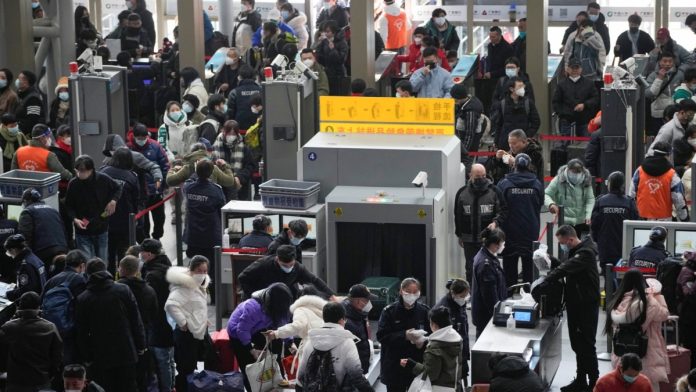Beijing —
Passengers laden with luggage flocked to rail stations and airports in China’s megacities on Monday, heading to their hometowns for Lunar New Year holidays that health experts fear could intensify a raging COVID-19 outbreak in areas less-equipped to handle it.
After three years of strict anti-virus controls, China abruptly abandoned its “zero COVID” policy in early December, letting the virus run freely through its 1.4 billion population.
Authorities said on Saturday nearly 60,000 people with COVID had died in hospitals between December 8 and January 12, a huge increase from previous figures that had been criticized by the World Health Organization for not reflecting the scale and severity of the outbreak.
Even those numbers most likely exclude many people dying at home, especially in rural areas with weaker medical systems, one health expert has said. Several experts forecast more than one million people in China will die from the disease this year.
Ahead of the Lunar New Year holidays, also known as the Spring Festival, which officially starts on January 21, state media has been filled with stories of rural hospitals and clinics bolstering their supplies of drugs and equipment.
“The peak of COVID infection in our village has passed, but the Spring Festival is approaching and there are still left-behind villagers, especially the elderly, at risk of secondary infection,” a doctor in Shaanxi province said in an article by regional news outlet Red Star News.
“If the anti-viral and other drugs were more abundant, I would be more confident,” the doctor added.
As well as fever drugs and oxygen supplies, China’s National Health Commission has said it would equip every village clinic with pulse oximeters, fingertip devices commonly used during the pandemic to quickly check oxygen levels.
Travel rush
Beijing’s main railway station has been packed with passengers leaving the capital in recent days, according to Reuters witnesses.
In China’s most populous city, Shanghai, temporary night trains have been added to meet demand for travelers heading to the eastern Anhui province, state news agency Xinhua reported.
Meanwhile, arrivals in the gambling hub of Macau exceeded 55,000 on Saturday, the highest daily figure since the pandemic began.
In Hong Kong, the government has said it would increase the number of people who can pass through designated land border control points to the mainland to 65,000 people per day from 50,000 between January 18 and January 21.
More than 2 billion trips across China are expected in the weeks around the holidays, its transport ministry has estimated.
The revival of travel in China has lifted expectations of a rebound in the world’s second-largest economy, which is suffering its lowest growth rates in nearly half a century.
Those hopes helped lift Asian equity markets. 0.9% on Monday, adding to gains of 4.2% last week.
China’s blue-chip index was up 2% while the yuan reached its highest since July. Global oil prices have also been supported on expectations of a recovery in demand from the world’s top importer China.
The first in a slew of economic data due this week showed China’s new home prices fell again in December as COVID-19 outbreaks hurt demand.
Other data on economic growth, retail sales and industrial output later in the week are certain to be dismal, but markets will likely look past that to how China’s reopening could bolster global growth, analysts say.
“Our baseline scenario assumes nationwide infections will peak in late January,” JP Morgan analysts said in a note on Monday.
The infection peak will catalyze a “sustainable” economic recovery from March onwards, with double-digit growth expected in the second quarter of the year, the analysts said.
China’s full-year growth is likely to rebound to 4.9% in 2023, before steadying in 2024, a Reuters poll showed.


